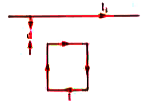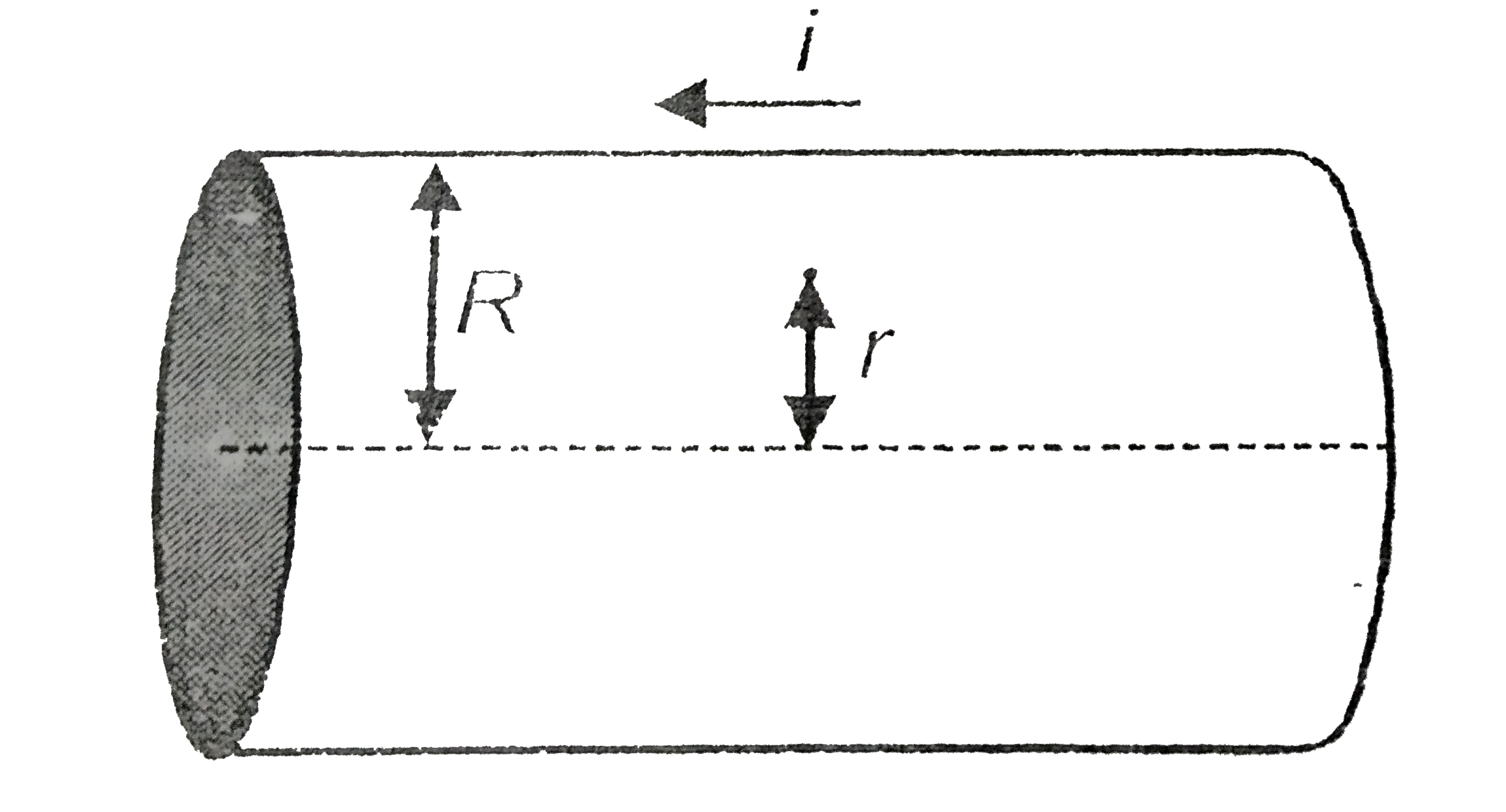The resistivity of cylindrical conductor carrying steady current along its length varies linearly with the distance from the current carrying end as given by ρ=ρ0(1+xl) where l is the length of the conductor and x is the distance from the current entry and. ρo is a positive constant.
Electric field varies linearly with x
Electric potential difference across the length varies linearly with x
Volume charge density in the conductor is zero
volume charge density in the conductor is non zero.
The correct Answer is:A, B
To solve the problem, we need to analyze the given information about the cylindrical conductor and its resistivity, and then determine the behavior of the electric field, electric potential difference, and volume charge density.
Step 1: Understand the resistivity variation
The resistivity of the cylindrical conductor is given by:
ρ(x)=ρ0(1+xl)
where:
- ρ0 is a positive constant,
- x is the distance from the current entry point,
- l is the total length of the conductor.
Step 2: Determine the electric field
Using the relationship between electric field E, current density J, and resistivity ρ:
E=ρ⋅J
Since the resistivity varies with x, we can substitute ρ(x):
E(x)=ρ0(1+xl)J
This shows that the electric field E also varies linearly with x because it is directly proportional to (1+xl).
Step 3: Determine the electric potential difference
The electric potential difference V across a length dx can be expressed as:
dV=−Edx
Substituting for E:
dV=−ρ0(1+xl)Jdx
To find the total potential difference V from 0 to x, we integrate:
V=−∫x0ρ0(1+x′l)Jdx′
Calculating the integral:
V=−Jρ0(x′+x′22l)x0=−Jρ0(x+x22l)
This shows that the potential difference V varies as a quadratic function of x (i.e., V∝x+x22l), indicating it does not vary linearly with x.
Step 4: Determine the volume charge density
Using the relationship between electric field and volume charge density ρv:
dEdx=ρvϵ
Substituting for E:
ddx(Jρ0(1+xl))=ρvϵ
Calculating the derivative:
dEdx=Jρ0l
Thus,
ρv=ϵJρ0l
Since J, ρ0, and l are constants, ρv is non-zero and constant.
Conclusion
1. Electric field E varies linearly with x.
2. Electric potential difference V does not vary linearly with x (it varies quadratically).
3. Volume charge density ρv is non-zero and constant.
The resistivity of the cylindrical conductor is given by:
ρ(x)=ρ0(1+xl)
where:
- ρ0 is a positive constant,
- x is the distance from the current entry point,
- l is the total length of the conductor.
Using the relationship between electric field E, current density J, and resistivity ρ:
E=ρ⋅J
Since the resistivity varies with x, we can substitute ρ(x):
E(x)=ρ0(1+xl)J
This shows that the electric field E also varies linearly with x because it is directly proportional to (1+xl).
The electric potential difference V across a length dx can be expressed as:
dV=−Edx
Substituting for E:
dV=−ρ0(1+xl)Jdx
To find the total potential difference V from 0 to x, we integrate:
V=−∫x0ρ0(1+x′l)Jdx′
Calculating the integral:
V=−Jρ0(x′+x′22l)x0=−Jρ0(x+x22l)
This shows that the potential difference V varies as a quadratic function of x (i.e., V∝x+x22l), indicating it does not vary linearly with x.
Using the relationship between electric field and volume charge density ρv:
dEdx=ρvϵ
Substituting for E:
ddx(Jρ0(1+xl))=ρvϵ
Calculating the derivative:
dEdx=Jρ0l
Thus,
ρv=ϵJρ0l
Since J, ρ0, and l are constants, ρv is non-zero and constant.
1. Electric field E varies linearly with x.
2. Electric potential difference V does not vary linearly with x (it varies quadratically).
3. Volume charge density ρv is non-zero and constant.
Topper's Solved these Questions
- CURRENT ELECTRICITYBook:AAKASH SERIESChapter:CURRENT ELECTRICITYExercise:ADDITIONAL PRACTICE EXERCISE (LEVEL -II PRACTICE SHEET (ADVANCED) (Linked Comprehension Type Questions))
Explore 9 Videos
- CURRENT ELECTRICITYBook:AAKASH SERIESChapter:CURRENT ELECTRICITYExercise:PROBLEMS
Explore 94 Videos
- CURRENT ELECTRICITYBook:AAKASH SERIESChapter:CURRENT ELECTRICITYExercise:ADDITIONAL PRACTICE EXERCISE (LEVEL -II PRACTICE SHEET (ADVANCED) (Straight Objective Type Questions))
Explore 5 Videos
- CURRENT ELECTRICITYBook:AAKASH SERIESChapter:CURRENT ELECTRICITYExercise:PROBLEMS (LEVEL-II)
Explore 27 Videos
- DUAL NATURE OF RADIATION AND MATTERBook:AAKASH SERIESChapter:DUAL NATURE OF RADIATION AND MATTERExercise:PRACTICE EXERCISEX
Explore 42 Videos
Similar Questions
A cylindrical conductor of radius R carrying current i along the axis such that the magnetic field inside the conductor varies as B=B0r2(0<r≤R), then which of the following in incorrect?
View SolutionThe density of a thin rod of length l varies with the distance x from one end as ρ=ρ0x2l2. Find the position of centre of mass of rod.
View SolutionA cylinderical conductor of radius R is carrying constant current. The plot of the magnitude of the magnetic field, B with the distance, d from the centre of the conductor , is correctly represented by the figure:
View SolutionThe density inside a solid sphere of radius a is given by ρ=ρ0r, where ρ0 is the density at the surface and r denotes the distance from the centre. Find the gravitational field due to this sphere at a distance 2a from its centre.
View SolutionThe density of a rod of length L varies as ρ=A+Bx where x is the distance from the left end. Locate the centre of mass.

View SolutionThe density inside a solid sphere of radius a is given by ρ=ρ0r, where ρ0 is the density ast the surface and r denotes the distance from the centre. Find the graittional field due to this sphere at a distance 2a from its centre.
View SolutionA square loop, carrying a steady current I, is placed in a horizontal plane near a long straight conductor carrying a steady current I1 at a distance d from the donductor as shown in figure. The loop will experience

View SolutionA long cylindrical conductor of radius R carries a current i as shown in the figure. The current density J varies across the cross-section as J=kr2, where, k is a constant. Find an expression for the magnetic field B at a distance r(<R) from the axis

View SolutionA thin but long, hollow, cylindrical tube of radius r carries a current i along its length. Find the magnitude of the magnetic field at a distance r/2 from the surface (a) inside the tube (b) outside the tube.
View SolutionThe cross-section area and length of cylindrical conductor are A and l respectively. The specific conductivity varies as σ(x)=σ0l√x, where x is the distance along the axis of the cylinder from one of its ends. Compute the resistance of the system along the cylindrical axis.
View Solution

